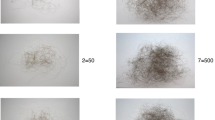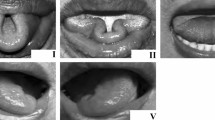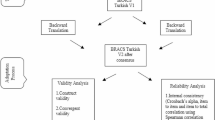Abstract
This article aims to offer a behavioural assessment strategy for oral sensitivity that can be readily applied in the clinical setting. Four children, ranging in age and with a variety of developmental and medical problems, were used as test cases for a task analysis of tolerance to touch probes in and around the mouth. In all cases, the assessment was sensitive to weekly measures of an intervention for oral sensitivity over a 3-week period. Employing an inexpensive, direct, specific to the individual, replicable, reliable, and effective measure for a specific sensory problem would fit better with the edicts of evidence-based practice. The current method offered the initial evidence towards this goal.
Similar content being viewed by others
References
Elitt CM, Malin SA, Koerber HR, Davis BM, Albers KM. Overexpression of artemin in the tongue increases expression of TRPV1 and TRPA1 in trigeminal afferents and causes oral sensitivity to capsaicin and mustard oil. Brain Res. 2008;1230:80–90.
Schuppan D. Current concepts of celiac disease pathogenesis. Gastroenterology. 2000;119:234–42.
Hayes JE, Duffy VB. Oral sensory phenotype identifies level of sugar and fat required for maximal liking. Physiol Behav. 2008;95:77–87.
Smith AM, Roux S, Naidoo NT, Venter DJL. Food choices of tactile defensive children. Nutrition. 2005;21:14–9.
Barnes S. Sense and sensitivity: parts 1 and 2. Speech Lang Ther Pract. 2001;4–7:16–8.
Ermer J, Dunn W. The sensory profile: a discriminant analysis of children with and without disabilities. Am J Occup Ther. 1997;52:283–90.
Fisher SE, Painter M, Milmoe G. Swallowing disorders in infancy. Pediatr Clin North Am. 1981;28:845–54.
Dunn W, Myles BS, Orr S. Sensory processing issues associated with Asperger syndrome: a preliminary investigation. Am J Occup Ther. 2002;56:97–102.
Smith-Myles B, Hagiwara T, Dunn W, Rinner L, Reese M, Huggins A, Becker S. Sensory issues in children with Asperger syndrome and autism. Educ Train Dev Disabil. 2004;39:283–90.
Watling RL, Deitz J, White O. Comparison of sensory profile of young children with and without autism spectrum disorders. Am J Occup Ther. 2001;55:416–23.
Vogel S. Oral motor and feeding problems in the tube fed infant: Suggested treatment strategies for occupational therapists. Occup Ther Health Care. 1986;3:63–79.
Dobbelsteyn C, Marche DM, Blake K, Rashid M. Early oral sensory experiences and feeding development in children with CHARGE syndrome: a report of five cases. Dysphagia. 2005;20:89–100.
Dodrill P, McMahon S, Ward E, Weir K, Donovan T, Riddle E. Long-term oral sensitivity and feeding skills of low-risk pre-term infants. Early Hum Dev. 2004;76:23–37.
Jacobs R, Serhal CB, Van Steenberghe D. Oral stereognosis: a review of the literature. Clin Oral Invest. 1998;2:3–10.
Jacobs R, Schotte A, Van Steenberghe D. Influence of temperature and foil hardness on interocclusal tactile threshold. J Periodontal Res. 1992;27:581–7.
Jacobs R, Wu CH, Van Loven K, Desnyder M, Kolenaar B, Van Steenberghe D. Methodology of oral sensory tests. J Oral Rehabil. 2002;29:720–30.
Gaba DM, Howard SK, Flanagan B, Smith BE, Fish KJ, Botney R. Assessment of clinical performance during simulated crises using both technical and behavioral ratings. Anesthesiology. 1998;89:123–47.
Small SD, Wuerz RC, Simon R, Shapiro N, Conn A, Setnik G. Demonstration of high-fidelity simulation team training for emergency medicine. Acad Emerg Med. 1999;6:312–23.
Dunn W. Development and validation of the short sensory profile. In: Dunn W, editor. The sensory profile examiner’s manual. San Antonio: The Psychological Corporation; 1999.
Dunn W, Daniels DB. Initial development of the infant/toddler sensory profile. J Early Interv. 2002;25:27–41.
Tomchek SD, Dunn W. Sensory processing in children with and without autism: a comparative study using the short sensory profile. Am J Occup Ther. 2007;61:190–200.
Campbell DT, Stanley JC. Experimental and quasi-experimental designs for research. Chicago: Rand McNally; 1963.
Platt JR. Strong inference. Science. 1964;146:347–53.
Dunn W. Performance of typical children on the sensory profile: an item analysis. Am J Occup Ther. 1994;48:967–74.
Winstock A. Eating and drinking difficulties in children: a guide for practitioners. Bicester: Speechmark; 2005. p. 2005.
Dovey TM, Staples PA, Gibson EL, Halford JCC. Food neophobia and ‘picky/fussy’ eating in children: a review. Appetite. 2008;50:181–93.
Cooper JO, Heron TE, Heward WL. Applied behavior analysis. 2nd ed. Upper Saddle River: Pearson; 2007.
Slagle J, Weinger MB, Dinh MTT, Brumer VV, Williams K. Assessment of the intrarater and interrater reliability of an established clinical task analysis methodology. Anesthesiology. 2002;96:1129–39.
Snell ME, Brown F. Instruction of students with severe disabilities. 6th ed. Englewood Cliffs: Prentice Hall; 2005.
Gloucestershire Government Website. 2012. http://www.gloucestershire.gov.uk/CHttpHandler.ashx?id=51703&p=0. Accessed 13 Mar 2012.
Butterfield WH, Parson R. Modeling and shaping by parents to develop chewing behaviour in their retarded children. J Behav Ther Exp Psychiatry. 1973;4:285–7.
Eckman N, Williams KE, Riegel K, Paul C. Teaching chewing: a structured approach. Am J Occup Ther. 2008;62:514–21.
Baranek GT, Berkson G. Tactile defensiveness in children with developmental disabilities: responsiveness and habituation. J Autism Dev Disord. 1994;24:457–71.
Marks I, Gelder M. A controlled retrospective study of behaviour therapy in phobic patients. Br J Psychiatry. 1965;111:561–73.
Ricciardi JN, Luiselli JK, Camare M. Shaping approach responses as intervention for specific phobia in a child with autism. J Appl Behav Anal. 2006;39:445–8.
McNally RJ. Choking phobia: a review of the literature. Compr Psychiatry. 1994;35:83–9.
Nock MK. A multiple-baseline evaluation of treatment of food phobia in a young boy. J Behav Ther Exp Psychiatry. 2002;33:217–25.
Bebko JM, Lennox C. Teaching the control of diurnal bruxism to two children with autism using a simple cueing procedure. Behav Ther. 1988;19:249–55.
Barnoy EL, Najdowski AC, Tarbox J, Wilke AE, Nollet MD. Evaluation of a multicomponent intervention for diurnal bruxism in a young child with autism. J Appl Behav Anal. 2009;42:845–8.
Piazza CC, Patel MR, Gulotta CS, Sevin BM, Layer SA. On the relative contributions of positive reinforcement and escape extinction in the treatment of food refusal. J Appl Behav Anal. 2003;36:309–24.
Coulthard H, Blissett J. Fruit and vegetable consumption in children and their mothers. Moderating effects of child sensory sensitivity. Appetite. 2009;52:410–5.
Dovey TM, Martin CI. A parent-led contingent reward desensitisation invention for children with a feeding problem resulting from sensory defensiveness. Infant Child Adolesc Nutr. 2012;4(6):384–93.
Gere DR, Capps SC, Mitchell DW, Grubbs E. Sensory sensitivity of gifted children. Am J Occup Ther. 2009;64:288–95.
Conflict of interest
The authors have no conflict of interest to disclose.
Author information
Authors and Affiliations
Corresponding author
Rights and permissions
About this article
Cite this article
Dovey, T.M., Aldridge, V.K. & Martin, C.I. Measuring Oral Sensitivity in Clinical Practice: A Quick and Reliable Behavioural Method. Dysphagia 28, 501–510 (2013). https://doi.org/10.1007/s00455-013-9460-2
Received:
Accepted:
Published:
Issue Date:
DOI: https://doi.org/10.1007/s00455-013-9460-2




